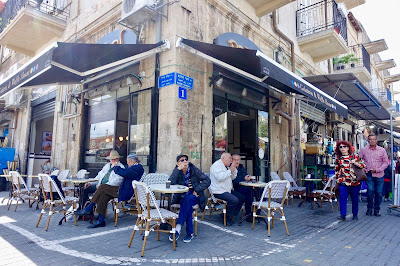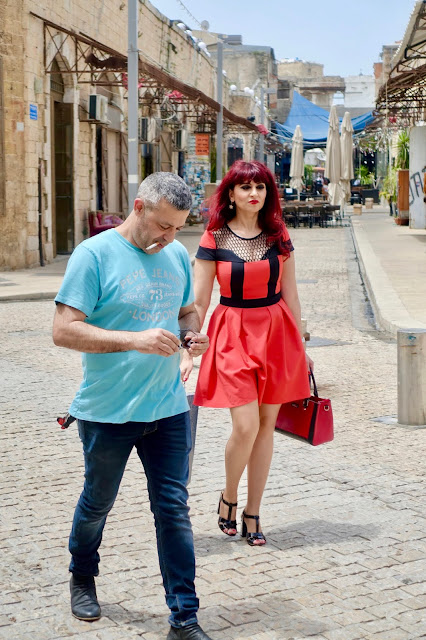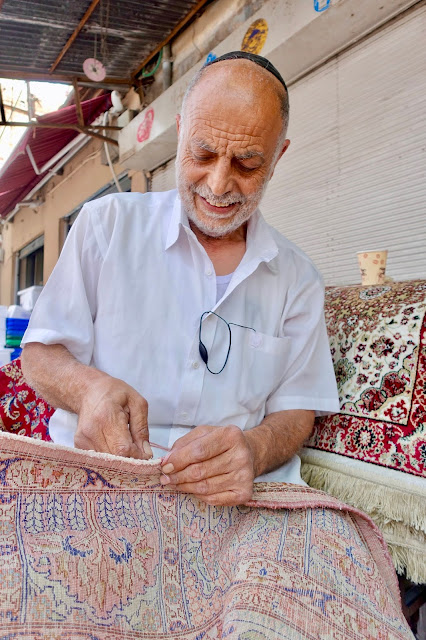Five years ago I spent a few nights in Hong Kong on my way to and from Australia. I went to a jazz concert, visited some temples and a beautiful synagogue and took the ferry to Macau. I enjoyed my short stay but didn't really engage with the place and left not really having seen the real Hong Kong. This year I decided to revisit and spent a total of six nights there, once more using Hong Kong as my stopover on a visit to Australia. I decided to take a different approach this time, avoiding the well known monuments and attractions and concentrating instead on discovering what remains of the old Hong Kong.
 |
| Calligrapher, Sheung Wan |
I have already written that this visit was to a large extent inspired by the iconic photography of
Fan Ho and by
Sunset Survivors the recent book by Lindsay Varty that documents some of Hong Kong's disappearing crafts and traditions. I carried out my search for the world of Fan Ho in the streets of Hong Kong in what proved to be a rich and sometimes surprising experience.
Despite the encroachment of modernity, glimpses of old Hong Kong can be seen almost everywhere. This includes groups of people playing mahjong or traditional card games, often for money in narrow alleys, courtyards of tenement buildings or in cafes and teashops. The arrival of an outsider does not perturb the players and on numerous occasions I was asked if I would like to pull up a chair. I can play a little but did not wish to lose my money so would politely decline. Most gambling is illegal here but for the more serious players there are legal mahjong parlours where vast amounts of money can be won or lost in a single session.
Whilst gambling is proscribed, prostitution is not. I was surprised to see young women tout for business in the street. They are particularly numerous in the area around Temple Street market but also work in other parts of the city. During the day they stand around looking bored and making half hearted attempts to attract interest before the more serious business of the evening. It is easy for misunderstandings to occur in the streets around the market. Between the massage parlours and brothels (which are illegal) there are other establishments displaying pictures of women in the window. It turns out that these are karaoke bars. The women in the pictures are featured singers and customers can pay to sing a duet with them. Something quite different to the service being sold in the street. The standard of is going is variable but these places are packed with locals almost every night.
 |
| Quartering the fish, North Point |
Temple Street has a night market largely frequented by tourists these days but for me the neighbourhood markets used by locals are more interesting. Fresh meat and fish are on sale everywhere. And I mean fresh. It is not unusual to see the fish still moving. Several times I saw fish put up strong resistance to getting the chop, jumping and trying to slither away from the fishmonger's knife. However, resistance is futile and always ends in defeat but even then, severed heads can be seen breathing, hearts pumping and sectioned eels wriggling. Whole pigs are delivered to butchers, dumped on the pavement at the entrance to the shop and then hauled in with a huge skewer. They are immediately quartered, sold and probably eaten before the day is out. There are many butchers and competition is fierce. Red metal lamp shades hang over the stalls to enhance the appearance of the meat, enriching the colour, emphasising its freshness and attracting customers. Some vendors sell tiny live frogs. These are also for consumption and I am advised some customers take them home still live and kill them themselves. Hong Kong's markets are not for the feint hearted. I am a vegetarian.
Food and its consumption is a social activity in Hong Kong. Almost every street has at least one neighbourhood style cafe or restaurant and little groups of fiends or relations can be seen sitting, eating and talking together. Even where people eat alone jokes and comments are shared between table. I stopped in several such places to snack and drink tea but unfortunately couldn't share the jokes not being able to understand Cantonese and the humour can be lost in translation. These little local places are in stark contrast to the skyscrapers and high powered business premises that dominate the skyline here and which represent Hong Kong for so many people. However I have no doubt that the skyscrapers provide many of the restaurants' customers.
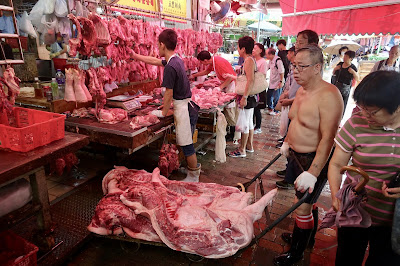 |
| Delivering whole pigs to the butcher |
 |
| Sunday brunch, Tsim Sha Tsui |
If I am traveling for more than a few days I like to visit a local barber. I do not care for modern salons and prefer a more traditional service. In London I have used the same Turkish barber shop for a number of years. The service includes a wet shave, hot towel, head and neck massage, threading and other painful activities all in the pursuit of male beauty. It also involves drinking copious amounts of Turkish coffee. I knew that a few, not dissimilar Shanghainese establishments still survive in Hong Kong and so visited the Kiu Kwun Barber Shop on Java Road in North Point. The ground floor has a long row of chairs each of them attended by a septuagenarian barber wearing a white coat and a mask covering mouth and nose. The chairs face long mirrors that enable the customer to see not only the barber but all of the comings and goings around him. A little surprised to see me, the manager asked who I was. Once he understood that not only was I a serious customer but also interested in the shop itself he asked me to come and see the first floor room. I climbed a narrow staircase and emerged to be greeted by the turned heads of a few older women sitting under enormous hair dryers, nursing magazines and looking slightly less than pleased to see me. Like the men, they sat in front of long mirrors encased by tiny colourful tiles that probably date from the 1950s.
I was shown around by Gao Tak Tin who arrived in Hong Kong in 1959 and initially lived in a squatter village. He began learning the trade at the age of 14 and practised on a watermelon so as not to hurt his customers and has now been a barber for almost 60 years. Mister Gao has seen many changes in style including at one time a mania for permed hair. Mercifully that style is long passed. Kiu Kwan is the largest remaining Shanghainese barber shop in Hong Kong and has 14 employees, not one of them below the age of 70. When the business finally closes a piece of history will be lost. I had a haircut and shave for just 70 dollars. That's about £7. Quite a bit more than my London barber charges.
 |
| Mister Gao Tak Tin in the Kiu Kwan barber shop |
Gao's style of barbering may be dying out in Hong Kong but other traditions linger on. The villain hitters are a group of elderly women who practice a form of sorcery under the Canal Road flyover between Causeway Bay and Wan Chai. As well as attracting people like me who want to observe and photograph them they continue to receive many local visitors who believe in their powers. They attempt to place a curse on the individual of one's choice by beating a paper effigy with a shoe whilst chanting about breaking their arms and legs. The ceremony ends with the burning of a paper tiger and the tossing of wooden dice to see if the spell has worked. Not wanting to cause trouble for anyone I elected instead to have any curses placed on me removed. I was invited to write my name of a piece of paper before bowing and waving three incense sticks three times at a small shrine. I then sat perfectly still whilst burning paper was circled three times around my head before the villain hitter declared me curse free and lucky. Throughout the whole process people were passing by, getting on and off buses and generally going about their business completely disinterested.
Still on the subject of effigies, I made a visit to Au-Yeung Ping Chi's shop. He hand makes paper representations (effigies) of the favourite items of deceased relatives that are then burned at their funerals in order to ensure they have everything they need in the next life. In the past families requested effigies of favourite pets, food, drink, mahjong sets, radios and other every day items. Au-Yeung says that today people ask for more luxurious goods including smartphones, designer clothes, luxury cars, palatial homes and the latest IT equipment. Looking around his shop I saw examples of several of the items as well as an aquarium complete with paper fish, made to order for someone whose passion had been collecting them. The hand made effigy business is now threatened by the import of mass produced items from China. This particular shop will close when the owner retires as he is not married and has no children.
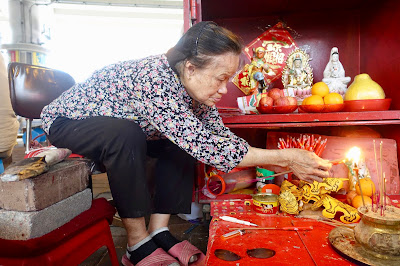 |
| Villain hitter, Canal Road |
 |
| Au-Yeung Ping Chi at work in his effigy shop |
About 16% of Hong Kong's population are 65 or older. They have a visible presence in the streets. streets - working, shopping, sitting with friends or looking after small children. I have already written about the elderly people who collect discarded cardboard in the streets and then sell it for recycling. In North Point I noticed an elderly woman sitting beside her collection of cardboard, almost certainly waiting for a dealer to come and take it from her. She seemed tired and bored. Despite this and the nature of her work she was smartly turned out in a patterned blue/ purple jacket and I couldn't resist a candid shot of her. As I clicked she looked up from her place in front of the fly posted walls and saw me. I smiled and to my delight she smiled back and waved. I went across to her but without a language in common we couldn't speak. She took my hand for a moment, indicated that it was OK to take her portrait and broke into a stunning smile.
Many of the older people I met were still working. Some, like Mister Yung who has a small stall in the jade market, explain that they don't need to work these days but do like to have "something to do" with a chance to socialise and pass the time. This was something I came across several times, often at the end of more harrowing stories about the past. People spoke freely about having survived the Japanese occupation of Shanghai in the Second World War only to have to flee China after the revolution. Not all the stories had happy endings and more than one included relatives having been shot or sent to re-education camps following failed attempts at escape. In some cases there was also a nostalgia for the 1980's and 1990's coupled with concern for the future.
 |
| Lady in blue, North Point |
 |
| The smile of a generous heart |
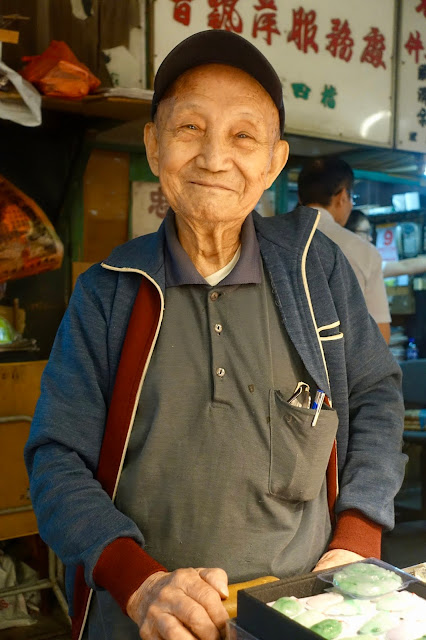 |
| Mister Yung, stallholder in the Jade Market |
My time in Hong Kong passed too quickly. I left wanting to continue my search for the old city and for the disappeared world of Fan Ho. As I wrote at the beginning of this post, there are glimpses of that world everywhere, not just in the alleys and side streets but also in the faces of the Sunday strollers in Sai Ying Pun, the antique hunters and street artists of Sheung Wan and the shoppers in the markets of North Point and Mong Kok. Did I feel as if I'd seen the real Hong Kong? Oh yes, but I left with a desire to see still more and hoping that despite rapid change it will still be possible to find it on my next visit.
As ever, I can't resist including a little more...
 |
| Sunday strollers, Sai Ying Pun |
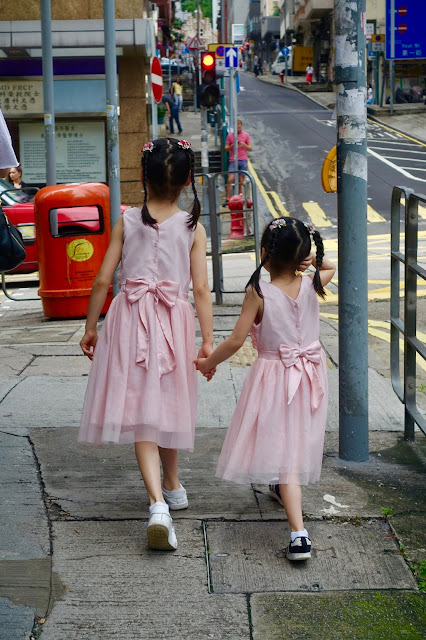 |
| Saturday ballet students, Sai Ying Pun |
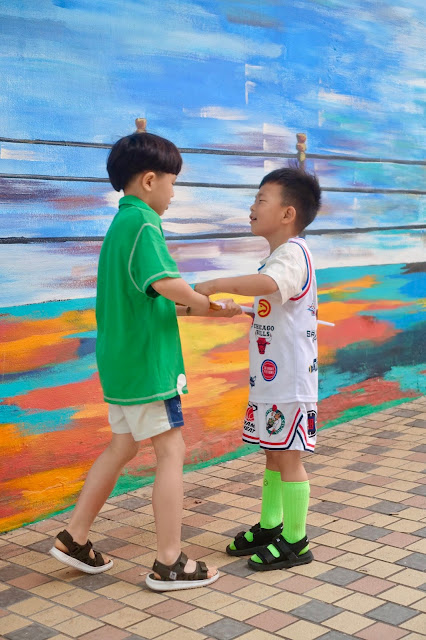 |
| Quarrel between friends, Sai Ying Pun |
 |
| Sense of humour, North Point |
 |
| Walking the dogs, Sai Ying Pun |
You might also like
Looking for the old City - Hong Kong Stories 2 or
Street Art and Selfies - Hong Kong Stories 1
You can see more pictures of Hong Kong
here.
I would like to note my thanks to Eric Wan who was tireless in tracking down people and places for me in Hong Kong and to Emily Gilman of
Ampersand who made many of the practical arrangements including securing Eric's excellent services! Thanks both.



